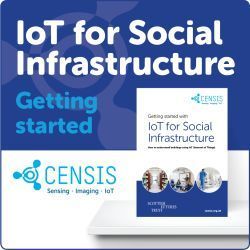
Scotland’s social infrastructure – the schools, hospitals, and other buildings and estates that support our public services – plays a crucial role in supporting our country’s communities, wellbeing, and economic growth. We all use these properties frequently without giving much thought to how they are managed and work.
Given its scale – the Scottish Government’s ‘civil estate’ totalled around 740,000m according to a 2011 study from the Scottish Futures Trust – using all this space effectively and efficiently is no mean feat. Social infrastructure can be a key contributor to Scotland’s aim of achieving a sustainable and inclusive net-zero carbon economy by 2045; however, to play its role, we need to know more about how these buildings are used and perform at an individual, estate, and even city-wide level.
Already an area of focus before the outbreak of Covid-19, the pandemic has only made that impetus even greater. The use of technology presents a huge opportunity to gain a better understanding of social infrastructure and the growth of IoT provides a range of new capabilities to connect these spaces.
As we describe in our latest report with the Scottish Futures Trust, Getting Started with IoT for Social Infrastructure, technology has advanced so much in recent years that we can now connect many more low-cost, small, battery-operated devices to the internet. It is a trend that will only accelerate, with some forecasts predicting that there will be
 50 billion connected devices in ten years’ time. By installing devices equipped with sensors, they can gather data and then send that information over the internet or private networks. Combined with the rise of low-cost cloud computing, this is enabling a vast amount of new opportunities, including the ability to detect and measure changes in a range of conditions – from light and vibration, to temperature or the presence of certain gases.
50 billion connected devices in ten years’ time. By installing devices equipped with sensors, they can gather data and then send that information over the internet or private networks. Combined with the rise of low-cost cloud computing, this is enabling a vast amount of new opportunities, including the ability to detect and measure changes in a range of conditions – from light and vibration, to temperature or the presence of certain gases.
If a local authority, or other organisation, wanted to better manage their buildings and inform decision-making, they could use sensors placed in rooms to assess their frequency of use. The same devices could also monitor a range of other temperature conditions and humidity – as a well carbon dioxide, noise, and light levels – to save on energy consumption and enhance comfort levels.
These types of applications are already being developed now, and more organisations across Scotland could take advantage of their transformational benefits.
An example of this in practice is Dundee-based M2M Cloud’s use of IoT sensors at multiple Highland Council buildings to help the local authority remotely gather data on its water system. The devices alert the council when temperatures move beyond guideline limits and may start to carry health risks, checks that previously had to be carried out manually. Displaying the data in one location and reacting to real-time changes makes for a much more effective and efficient process.
The project was just one potential use of sensor technology. Housing associations are exploring how humidity and temperature checks can help identify people living in fuel poverty and prevent damage to social housing stocks. Another application could be its use in transport networks to count the number of people in certain areas, and understand when and how they move through stations. This would lead to a better understanding of capacity constraints and use of space, which will be important considerations in the months ahead.
These are only a few illustrations of what is possible, but IoT is here – never before has technology offered such opportunity. The public sector can realise the benefits of IoT and act as a catalyst for change in other areas of our economy. It’s time for organisations across the country to take advantage of the transformational benefits of the technologies and expertise already available.